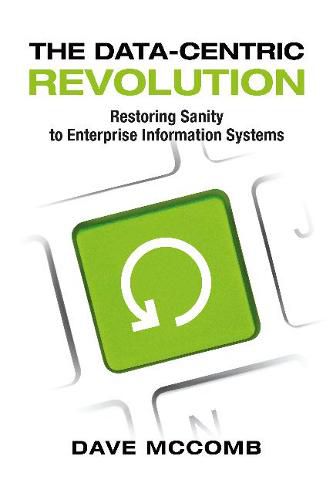The Data-Centric Revolution: Restoring Sanity to Enterprise Information Systems
Dave McComb

The Data-Centric Revolution: Restoring Sanity to Enterprise Information Systems
Dave McComb
This title is printed to order. This book may have been self-published. If so, we cannot guarantee the quality of the content. In the main most books will have gone through the editing process however some may not. We therefore suggest that you be aware of this before ordering this book. If in doubt check either the author or publisher’s details as we are unable to accept any returns unless they are faulty. Please contact us if you have any questions.
Shift from application-centric to data-centric to enable your organization to develop more efficient and successful Enterprise Information Systems. This book is the first part of a trilogy to follow Software Wasteland. In Software Wasteland, we detailed the current poor state of application software development. We offered some tactical advice for reducing some of the worse of the excess. This is the first book in the what to do instead trilogy. Even if the thought of data modeling makes you cringe, Dave McCombs latest book makes the case that it is a necessary exercise for the data-driven organization. The Data-Centric Revolution shows how to be data-driven in an extensible, flexible way that is baked-into organizational culture, rather than taking a typical project-by-project approach. The book is a fun, insightful and meaty read, well-illustrated, and with endless wonderful examples. Doug Laney, Principal, Data & Analytics Strategy, Caserta, and author of the best-seller, Infonomics: How to Monetize, Manage, and Measure Information for Competitive Advantage Dave McComb has laid out a roadmap to travel the exciting path towards data centricity. Daves passion for semantic modeling is contagious and his expert advice will give you the motivation to rethink application development and the direction needed to deliver value in your organization with linked data. Nic Seyot, Executive Director, Information Management at a major investment bank. In his new book, Dave teaches us why most of the stack we’ve spent decades trying to maintain is just a big, unmanageable pile of duplicative, inflexible code. He shows us how to collapse the stack and blend the logic and data each business needs to thrive, in one contextually rich, machine readable, dynamic, smart data layer. The bloated app and process layers of the stack go away, leaving a thin execution layer calling on the power of the smart data underneath. After Software Wasteland explained the problem, The Data-Centric Revolution articulates the solution. Alan Morrison, Sr. Research Fellow, New Services and Emerging Tech, PwC. From the age of punched cards to todays internet-driven systems, one thing has stayed fairly constant: software vendors and their implementers have been driving the Enterprise IT industry. This is changing. It will be hard to see initially, but its already happening in some more prescient organizations. As organizations realize they can take control of their own destiny by adopting data-centric principles, they will see their dependency on application software wither. The cost of running internal information systems will drop at least ten-fold, and the cost of integrating them will drop even more rapidly. This will decimate the $400 billion/ year application software industry and the $400 billion/year systems integration industry. The benefit will accrue to the buyers, and will accrue earliest to the first movers. The trajectory of this book is as follows: Chapters 1 through 3 lay the data-centric foundation. Chapter 1 introduces the data-centric movement and the prerequisites that must be in place for success (including roles and responsibilities). Chapter 2 defines data-centric and explores a data-centric vision and approaches. Chapter 3 covers the management requirements in achieving a data-centric paradigm shift and reveals the new modeling discipline and delivery architecture. Chapters 4 through 6 explain the data-centric approach and its rewards. Chapter 4 summarizes why the data-centric approach will save incredible amounts of time and money. Chapter 5 explores various data centric approaches, and the underlying themes of flexibility and simplicity. Chapter 6 broadens the discussion of paradigm shifts and also discusses who will help you lead this data-centric approach. Chapters 7 through 10 discuss case studies and ways of organizing data. Chapters 7 and 10 discuss several case studies that have taken the data-centric approach. Chapter 8 explains linked data and semantic technologies, and Chapter 9 ontologies and knowledge graphs. Chapters 11 through 13 dig deeper into the pitfalls of the application-centric mindset and the benefits of the data-centric mindset. Chapter 11 gets to the root of the application-centric mindset: application software. Chapter 12 reveals the benefits of code reduction and Chapter 13 the benefits of the model-driven approach. Chapters 14 through 18 explain how to implement the data-centric paradigm. Chapter 14 explains how new technologies fit in with the data-centric approach. Chapters 15 and 16 cover how to get started. Chapter 17 explains the important role of governance in the data-centric approach. Chapter 18 summarizes the key takeaways.
This item is not currently in-stock. It can be ordered online and is expected to ship in 7-14 days
Our stock data is updated periodically, and availability may change throughout the day for in-demand items. Please call the relevant shop for the most current stock information. Prices are subject to change without notice.
Sign in or become a Readings Member to add this title to a wishlist.


